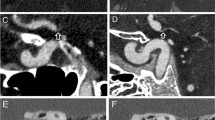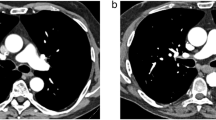Abstract
Objectives
To compare single-energy (SECT) and dual-energy (DECT) abdominal CT examinations in matched patient cohorts regarding differences in radiation dose and image quality performed with second- and third-generation dual-source CT (DSCT).
Methods
We retrospectively analysed 200 patients (100 male, 100 female; mean age 61.2 ± 13.5 years, mean body mass index 27.5 ± 3.8 kg/m2) equally divided into four groups matched by gender and body mass index, who had undergone portal venous phase abdominal CT with second-generation (group A, 120-kV-SECT; group B, 80/140-kV-DECT) and third-generation DSCT (group C, 100-kV-SECT; group D, 90/150-kV-DECT). The radiation dose was normalised for 40-cm scan length. Dose-independent figure-of-merit (FOM) contrast-to-noise ratios (CNRs) were calculated for various organs and vessels. Subjective overall image quality and reader confidence were assessed.
Results
The effective normalised radiation dose was significantly lower (P < 0.001) in groups C (6.2 ± 2.0 mSv) and D (5.3 ± 1.9 mSv, P = 0.103) compared to groups A (8.8 ± 2.3 mSv) and B (9.7 ± 2.4 mSv, P = 0.102). Dose-independent FOM-CNR peaked for liver, kidney, and portal vein measurements (all P ≤ 0.0285) in group D. Subjective image quality and reader confidence were consistently rated as excellent in all groups (all ≥1.53 out of 5).
Conclusions
With both DSCT generations, abdominal DECT can be routinely performed without radiation dose penalty compared to SECT, while third-generation DSCT shows improved dose efficiency.
Key Points
• Dual-source CT (DSCT) allows for single- and dual-energy image acquisition.
• Dual-energy acquisition does not increase the radiation dose in abdominal DSCT.
• Third-generation DSCT shows improved dose efficiency compared to second-generation DSCT.
• Dose-independent figure-of-merit image contrast was highest with third-generation dual-energy DSCT.
• Third-generation DSCT shows improved dose efficiency for SECT and DECT.

Similar content being viewed by others
References
Graser A, Johnson TR, Chandarana H, Macari M (2009) Dual energy CT: preliminary observations and potential clinical applications in the abdomen. Eur Radiol 19:13–23
Silva AC, Morse BG, Hara AK, Paden RG, Hongo N, Pavlicek W (2011) Dual-energy (spectral) CT: applications in abdominal imaging. Radiographics 31:1031–1046, discussion 1047-1050
Heye T, Nelson RC, Ho LM, Marin D, Boll DT (2012) Dual-energy CT applications in the abdomen. AJR Am J Roentgenol 199:S64–70
Marin D, Boll DT, Mileto A, Nelson RC (2014) State of the art: dual-energy CT of the abdomen. Radiology 271:327–342
Morgan DE (2014) Dual-energy CT of the abdomen. Abdom Imaging 39:108–134
Johnson TR, Krauss B, Sedlmair M et al (2007) Material differentiation by dual energy CT: initial experience. Eur Radiol 17:1510–1517
Joe E, Kim SH, Lee KB et al (2012) Feasibility and accuracy of dual-source dual-energy CT for noninvasive determination of hepatic iron accumulation. Radiology 262:126–135
Luo XF, Xie XQ, Cheng S et al (2015) Dual-energy CT for patients suspected of having liver iron overload: can virtual iron content imaging accurately quantify liver iron content? Radiology 277:95–103
Bauer RW, Schulz JR, Zedler B, Graf TG, Vogl TJ (2010) Compound analysis of gallstones using dual energy computed tomography—results in a phantom model. Eur J Radiol 75:e74–80
Graser A, Johnson TR, Bader M et al (2008) Dual energy CT characterization of urinary calculi: initial in vitro and clinical experience. Investig Radiol 43:112–119
Nattenmuller J, Hosch W, Nguyen TT et al (2015) Hypodense liver lesions in patients with hepatic steatosis: do we profit from dual-energy computed tomography? Eur Radiol 25:3567–3576
Mileto A, Sofue K, Marin D (2016) Imaging the renal lesion with dual-energy multidetector CT and multi-energy applications in clinical practice: what can it truly do for you? Eur Radiol. doi:10.1007/s00330-015-4180-7
Mileto A, Nelson RC, Marin D, Roy Choudhury K, Ho LM (2015) Dual-energy multidetector CT for the characterization of incidental adrenal nodules: diagnostic performance of contrast-enhanced material density analysis. Radiology 274:445–454
Wichmann JL, Booz C, Wesarg S et al (2014) Dual-energy CT-based phantomless in vivo three-dimensional bone mineral density assessment of the lumbar spine. Radiology 271:778–784
Meinel FG, Bischoff B, Zhang Q, Bamberg F, Reiser MF, Johnson TR (2012) Metal artifact reduction by dual-energy computed tomography using energetic extrapolation: a systematically optimized protocol. Investig Radiol 47:406–414
Schabel C, Bongers M, Sedlmair M et al (2014) Assessment of the hepatic veins in poor contrast conditions using dual energy CT: evaluation of a novel monoenergetic extrapolation software algorithm. Röfo 186:591–597
Mileto A, Ramirez-Giraldo JC, Marin D et al (2014) Nonlinear image blending for dual-energy MDCT of the abdomen: can image quality be preserved if the contrast medium dose is reduced? AJR Am J Roentgenol 203:838–845
De Cecco CN, Darnell A, Macias N et al (2013) Second-generation dual-energy computed tomography of the abdomen: radiation dose comparison with 64- and 128-row single-energy acquisition. J Comput Assist Tomogr 37:543–546
Jepperson MA, Cernigliaro JG, el Ibrahim SH, Morin RL, Haley WE, Thiel DD (2015) In vivo comparison of radiation exposure of dual-energy CT versus low-dose CT versus standard CT for imaging urinary calculi. J Endourol 29:141–146
(2007) The 2007 recommendations of the International Commission on Radiological Protection. ICRP publication 103. Ann ICRP 37:1–332
Christner JA, Kofler JM, McCollough CH (2010) Estimating effective dose for CT using dose-length product compared with using organ doses: consequences of adopting International Commission on Radiological Protection publication 103 or dual-energy scanning. AJR Am J Roentgenol 194:881–889
Schindera ST, Nelson RC, Mukundan S Jr et al (2008) Hypervascular liver tumors: low tube voltage, high tube current multi-detector row CT for enhanced detection--phantom study. Radiology 246:125–132
Nakaura T, Awai K, Maruyama N et al (2011) Abdominal dynamic CT in patients with renal dysfunction: contrast agent dose reduction with low tube voltage and high tube current-time product settings at 256-detector row CT. Radiology 261:467–476
Guimaraes LS, Fletcher JG, Harmsen WS et al (2010) Appropriate patient selection at abdominal dual-energy CT using 80 kV: relationship between patient size, image noise, and image quality. Radiology 257:732–742
Primak AN, Giraldo JC, Eusemann CD et al (2010) Dual-source dual-energy CT with additional tin filtration: dose and image quality evaluation in phantoms and in vivo. AJR Am J Roentgenol 195:1164–1174
Purysko AS, Primak AN, Baker ME et al (2014) Comparison of radiation dose and image quality from single-energy and dual-energy CT examinations in the same patients screened for hepatocellular carcinoma. Clin Radiol 69:e538–544
Winklehner A, Gordic S, Lauk E et al (2015) Automated attenuation-based tube voltage selection for body CTA: performance evaluation of 192-slice dual-source CT. Eur Radiol 25:2346–2353
Gordic S, Morsbach F, Schmidt B et al (2014) Ultralow-dose chest computed tomography for pulmonary nodule detection: first performance evaluation of single energy scanning with spectral shaping. Investig Radiol 49:465–473
Solomon J, Mileto A, Ramirez-Giraldo JC, Samei E (2015) Diagnostic performance of an advanced modeled iterative reconstruction algorithm for low-contrast detectability with a third-generation dual-source multidetector CT scanner: potential for radiation dose reduction in a multireader study. Radiology 275:735–745
Smith-Bindman R, Lipson J, Marcus R et al (2009) Radiation dose associated with common computed tomography examinations and the associated lifetime attributable risk of cancer. Arch Intern Med 169:2078–2086
Patient safety: radiation dose in X-ray and CT exams. Available via http://www.radiologyinfo.org/en/safety/?pg=sfty_xray#part3. Accessed 28 April 2015
Mangold S, Thomas C, Fenchel M et al (2012) Virtual nonenhanced dual-energy CT urography with tin-filter technology: determinants of detection of urinary calculi in the renal collecting system. Radiology 264:119–125
De Cecco CN, Darnell A, Macias N et al (2013) Virtual unenhanced images of the abdomen with second-generation dual-source dual-energy computed tomography: image quality and liver lesion detection. Investig Radiol 48:1–9
Graser A, Johnson TR, Hecht EM et al (2009) Dual-energy CT in patients suspected of having renal masses: can virtual nonenhanced images replace true nonenhanced images? Radiology 252:433–440
Krauss B, Grant KL, Schmidt BT, Flohr TG (2015) The importance of spectral separation: an assessment of dual-energy spectral separation for quantitative ability and dose efficiency. Investig Radiol 50:114–118
Acknowledgements
The scientific guarantor of this publication is Carlo N. De Cecco. The authors of this manuscript declare relationships with the following companies: UJS is a consultant for and/or receives research support from Astellas, Bayer, Bracco, GE, Medrad, and Siemens. CC is an employee of Siemens Medical Solutions. The other authors have no conflict of interest to disclose. The authors state that this work has not received any funding. No complex statistical methods were necessary for this paper. Institutional Review Board approval was obtained. Written informed consent was waived by the Institutional Review Board. No study subjects or cohorts have been previously reported. Methodology: retrospective, cross-sectional study, performed at one institution.
Author information
Authors and Affiliations
Corresponding author
Rights and permissions
About this article
Cite this article
Wichmann, J.L., Hardie, A.D., Schoepf, U.J. et al. Single- and dual-energy CT of the abdomen: comparison of radiation dose and image quality of 2nd and 3rd generation dual-source CT. Eur Radiol 27, 642–650 (2017). https://doi.org/10.1007/s00330-016-4383-6
Received:
Revised:
Accepted:
Published:
Issue Date:
DOI: https://doi.org/10.1007/s00330-016-4383-6




